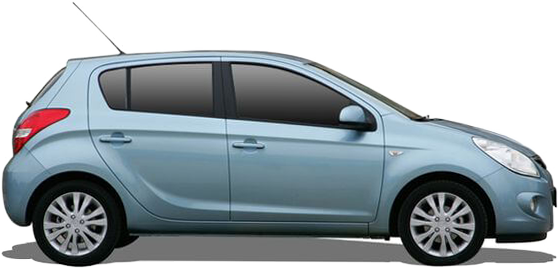The Comparative Analysis :
Hyundai i20 5-door 1.2 LPG (Petrol) (09 - 10) vs. Renault Clio dCi 105 FAP (09 - 10)
€ 14,700

€ 19,100

€ 14,700
Base Price ⓘBase price of a new vehicle with standard equipment in Germany at market launch.
€ 19,100
ⓘBase price of a new vehicle with standard equipment in Germany at market launch. Price Info
Vehicle Dimensions
The Hyundai i20 1.2 LPG is slightly smaller in every dimension. It's 9.2 cm shorter, 1 cm narrower and 0.7 cm lower than the Renault Clio dCi 105 FAP.
Hyundai i20 1.2 LPG
Renault Clio dCi 105 FAP
1490
1710
1985
1497
1720
2025
1710 mm
Width
1720 mm
1985 mm
Width Incl. Mirrors
2025 mm
1490 mm
Height
1497 mm
2525
3940
2575
4032
3940 mm
Length
4032 mm
2525 mm
Wheelbase
2575 mm
Vehicle Weight
Hyundai i20 1.2 LPG
Renault Clio dCi 105 FAP
1045 kg
Kerb Weight
1275 kg
1515 kg
Gross Vehicle
Weight
Weight
1690 kg

Weight Difference:
230 kg
18.04 %

General
Hyundai i20 1.2 LPG
Renault Clio dCi 105 FAP
PB
Generation
R
Hatchback
Car Body Style
Hatchback
Unleaded (95 RON)
Fuel Type
Diesel

Front-wheel drive
Drive
Front-wheel drive

5-speed manual transmission
Transmission
6-speed manual transmission
Engine
Hyundai i20 1.2 LPG
Renault Clio dCi 105 FAP
Straight-four engine (naturally aspirated engine)
Engine Type
Straight-four diesel engine with turbocharger
4
Valves
4
4
Cylinders
4
1248 CC
Engine Capacity
1461 CC
77 bhp
at 6000 rpm
Power
102 bhp
at 4000 rpm
Hyundai i20 1.2 LPG
77 bhp
102 bhp
Renault Clio dCi 105 FAP
119 NM
at 4000 rpm
Max. Torque
240 NM
at 2000 rpm
Hyundai i20 1.2 LPG
119 NM
240 NM
Renault Clio dCi 105 FAP
Performance
Hyundai i20 1.2 LPG
Renault Clio dCi 105 FAP
103 mph
Maximum Speed
116 mph
12.9 sec
Acceleration 0 to 62 mph
11.3 sec
62 mph
62
mph
mph
179 m
0.000 sec

Hyundai i20 1.2 LPG
62 mph
62
mph
mph
157 m
0.000 sec

Renault Clio dCi 105 FAP
▶ REPLAY
13.57 kg/bhp
Weight-to-Power Ratio
12.5 kg/bhp
Hyundai i20 1.2 LPG
13.57 kg/bhp
12.5 kg/bhp
Renault Clio dCi 105 FAP
Fuel Economy / Emissions
Hyundai i20 1.2 LPG
Renault Clio dCi 105 FAP
Fuel Economy
54 mpg
combined
60 mpg
Hyundai i20 1.2 LPG
54 mpg
60 mpg
Renault Clio dCi 105 FAP
44 mpg
city
50 mpg
63 mpg
motorway
67 mpg
45 L
Fuel Tank Capacity
55 L
537 mi
Range
727 mi
Hyundai i20 1.2 LPG
537 mi
727 mi
Renault Clio dCi 105 FAP
Environmental Impact
98.5 kWh
Total Energy Consumption
per 100 miles ⓘThe total energy consumption per 100 miles is the amount of energy consumed by a vehicle when burning fuel or using electricity per 100 miles (final energy), and the energy required to produce the appropriate amount of fuel or electricity (primary energy).
per 100 miles ⓘThe total energy consumption per 100 miles is the amount of energy consumed by a vehicle when burning fuel or using electricity per 100 miles (final energy), and the energy required to produce the appropriate amount of fuel or electricity (primary energy).
96.7 kWh
Hyundai i20 1.2 LPG
98.5 kWh
96.7 kWh
Renault Clio dCi 105 FAP
Euro 4, 5L
Emission Standard
Euro 4 / Euro 5
124 g/km (NEFZ)
CO2 Emissions
124 g/km (NEFZ)
Practical Convenience
Hyundai i20 1.2 LPG
Renault Clio dCi 105 FAP
5
Doors
3
5
No. of Seats
5
470 kg
Maximum Payload
415 kg
295 L
Boot Capacity
288 L






1060 L
Boot Capacity (Seats Down)
1038 L


















